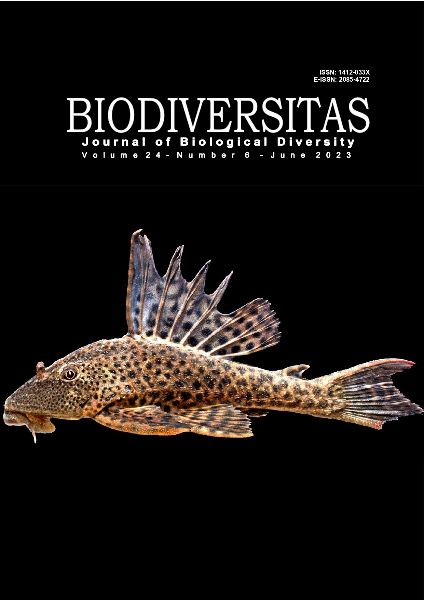The diversity and regional conservation status of wild edible fruit species in Sumatra, Indonesia
##plugins.themes.bootstrap3.article.main##
Abstract
Abstract. Suwardi AB, Syamsuardi, Mukhtar E, Nurainas. 2023. The diversity and regional conservation status of wild edible fruit species in Sumatra, Indonesia. Biodiversitas 24: 3245-3257. Sumatra Island is recognized as the distribution center of tropical fruit species in Indonesia. However, increased human activity threatens the existence of edible wild fruit plants in nature. The study aims to assess the diversity and regional conservation status of wild edible fruit plant species in Sumatra, Indonesia. The study was conducted in four provinces: West Sumatra, Riau, Jambi, and Bengkulu. For the sampling, a modified line transect method was used. A total of 331 wild edible fruit plant species at four studied sites in Sumatra consisted of 73 families. The highest number of fruit plant species was recorded in West Sumatra Province, i.e., 176 species, followed by Jambi (172 species), Riau (121 species), and Bengkulu (76 species). The diversity of wild edible fruit plant species was higher in West Sumatra Province (3.85) but lower in Riau Province (3.25). Artocarpus integer (Thunb.) Merr., Baccaurea lanceolata (Miq.) Müll.Arg., Baccaurea macrocarpa (Miq.) Müll.Arg., Baccaurea polyneura Hook.f., Garcinia atroviridis Griff. ex T.Anderson, Garcinia xanthochymus Hook.fil. ex J.Anderson, Mangifera foetida Lour., Mangifera laurina Blume, Mangifera odorata Griff., and Pometia pinnata J.R.Forst. & G.Forst. were the most frequently recorded wild fruit plant species in all of the study area. However, 74 wild edible fruit plant species were recorded only in West Sumatra, 45 in Riau, 79 in Jambi, and 9 in Bengkulu. Among the 331 wild edible fruit species in the present study, 1 taxon was classified as endangered (0.30%), 9 taxa (2.72%) as vulnerable, 11 taxa (3.32%) as near threatened, and 139 taxa (41.99%) as least concern, and 171 taxa (51.67%) as Data Deficient.
##plugins.themes.bootstrap3.article.details##
Most read articles by the same author(s)
- ADI BEJO SUWARDI, ZIDNI ILMAN NAVIA, TISNA HARMAWAN, SYAMSUARDI, ERIZAL MUKHTAR, Ethnobotany and conservation of indigenous edible fruit plants in South Aceh, Indonesia , Biodiversitas Journal of Biological Diversity: Vol. 21 No. 5 (2020)
- ELFRIDA, NINTA SABRINA TARIGAN, ADI BEJO SUWARDI, Ethnobotanical study of medicinal plants used by community in Jambur Labu Village, East Aceh, Indonesia , Biodiversitas Journal of Biological Diversity: Vol. 22 No. 7 (2021)
- IMAM HADI SUTRISNO, BACHTIAR AKOB, ZIDNI ILMAN NAVIA, NURAINI, ADI BEJO SUWARDI, Documentation of ritual plants used among the Aceh tribe in Peureulak, East Aceh District, Indonesia , Biodiversitas Journal of Biological Diversity: Vol. 21 No. 11 (2020)
- ELFRIDA, ALBIAN MUBARAK, ADI BEJO SUWARDI, Short Communication: The fruit plant species diversity in the home gardens and their contribution to the livelihood of communities in rural area , Biodiversitas Journal of Biological Diversity: Vol. 21 No. 8 (2020)
- ZIDNI ILMAN NAVIA, DITA AUDIRA, NURUL AFIFAH, KASANOVA TURNIP, NURAINI, ADI BEJO SUWARDI, Ethnobotanical investigation of spice and condiment plants used by the Taming tribe in Aceh, Indonesia , Biodiversitas Journal of Biological Diversity: Vol. 21 No. 10 (2020)
- ZIDNI ILMAN NAVIA, ADI BEJO SUWARDI, BAIHAQI, Ethnobotanical study of medicinal plants used by local communities in Sekerak Subdistrict, Aceh Tamiang, Indonesia , Biodiversitas Journal of Biological Diversity: Vol. 22 No. 10 (2021)
- ADI BEJO SUWARDI, MARDUDI, ZIDNI ILMAN NAVIA, BAIHAQI, MUNTAHA, Documentation of medicinal plants used by Aneuk Jamee tribe in Kota Bahagia Sub-district, South Aceh, Indonesia , Biodiversitas Journal of Biological Diversity: Vol. 22 No. 1 (2021)
- IMAM HADI SUTRISNO, ADI BEJO SUWARDI, ZIDNI ILMAN NAVIA, BAIHAQI, MUHAMMAD ARIF FADHILAH, Documentation of the traditional Alas food in Southeast Aceh district, Indonesia , Biodiversitas Journal of Biological Diversity: Vol. 22 No. 8 (2021)
- TRY SURYA HARAPAN, NURAINAS, SYAMSUARDI, AHMAD TAUFIQ, Identifying the potential geographic distribution for Castanopsis argentea and C. tungurrut (Fagaceae) in the Sumatra Conservation Area Network, Indonesia , Biodiversitas Journal of Biological Diversity: Vol. 23 No. 4 (2022)
- ADI BEJO SUWARDI, ZIDNI ILMAN NAVIA, TISNA HARMAWAN, SEPRIANTO, SYAMSUARDI, ERIZAL MUKHTAR, Diversity of wild edible fruit plant species and their threatened status in the Aceh Province, Indonesia , Biodiversitas Journal of Biological Diversity: Vol. 23 No. 3 (2022)

